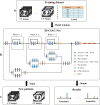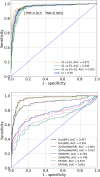AI detection of mild COVID-19 pneumonia from chest CT scans
- PMID: 33738595
- PMCID: PMC7971359
- DOI: 10.1007/s00330-021-07797-x
AI detection of mild COVID-19 pneumonia from chest CT scans
Abstract
Objectives: An artificial intelligence model was adopted to identify mild COVID-19 pneumonia from computed tomography (CT) volumes, and its diagnostic performance was then evaluated.
Methods: In this retrospective multicenter study, an atrous convolution-based deep learning model was established for the computer-assisted diagnosis of mild COVID-19 pneumonia. The dataset included 2087 chest CT exams collected from four hospitals between 1 January 2019 and 31 May 2020. The true positive rate, true negative rate, receiver operating characteristic curve, area under the curve (AUC) and convolutional feature map were used to evaluate the model.
Results: The proposed deep learning model was trained on 1538 patients and tested on an independent testing cohort of 549 patients. The overall sensitivity was 91.5% (195/213; p < 0.001, 95% CI: 89.2-93.9%), the overall specificity was 90.5% (304/336; p < 0.001, 95% CI: 88.0-92.9%) and the general AUC value was 0.955 (p < 0.001).
Conclusions: A deep learning model can accurately detect COVID-19 and serve as an important supplement to the COVID-19 reverse transcription-polymerase chain reaction (RT-PCR) test.
Key points: • The implementation of a deep learning model to identify mild COVID-19 pneumonia was confirmed to be effective and feasible. • The strategy of using a binary code instead of the region of interest label to identify mild COVID-19 pneumonia was verified. • This AI model can assist in the early screening of COVID-19 without interfering with normal clinical examinations.
Keywords: Artificial intelligence; COVID-19; Computer-assisted diagnosis; Deep learning; Volume CT.
© 2021. European Society of Radiology.
Conflict of interest statement
The authors of this manuscript declare no relationships with any companies whose products or services may be related to the subject matter of the article.
Figures




Similar articles
-
Using Artificial Intelligence to Detect COVID-19 and Community-acquired Pneumonia Based on Pulmonary CT: Evaluation of the Diagnostic Accuracy.Radiology. 2020 Aug;296(2):E65-E71. doi: 10.1148/radiol.2020200905. Epub 2020 Mar 19. Radiology. 2020. PMID: 32191588 Free PMC article.
-
From community-acquired pneumonia to COVID-19: a deep learning-based method for quantitative analysis of COVID-19 on thick-section CT scans.Eur Radiol. 2020 Dec;30(12):6828-6837. doi: 10.1007/s00330-020-07042-x. Epub 2020 Jul 18. Eur Radiol. 2020. PMID: 32683550 Free PMC article.
-
An original deep learning model using limited data for COVID-19 discrimination: A multicenter study.Med Phys. 2022 Jun;49(6):3874-3885. doi: 10.1002/mp.15549. Epub 2022 Apr 18. Med Phys. 2022. PMID: 35305027 Free PMC article.
-
Diagnostic performance of corona virus disease 2019 chest computer tomography image recognition based on deep learning: Systematic review and meta-analysis.Medicine (Baltimore). 2022 Oct 21;101(42):e31346. doi: 10.1097/MD.0000000000031346. Medicine (Baltimore). 2022. PMID: 36281129 Free PMC article.
-
Thoracic imaging tests for the diagnosis of COVID-19.Cochrane Database Syst Rev. 2020 Sep 30;9:CD013639. doi: 10.1002/14651858.CD013639.pub2. Cochrane Database Syst Rev. 2020. Update in: Cochrane Database Syst Rev. 2020 Nov 26;11:CD013639. doi: 10.1002/14651858.CD013639.pub3. PMID: 32997361 Updated.
Cited by
-
A Systematic Review on Deep Structured Learning for COVID-19 Screening Using Chest CT from 2020 to 2022.Healthcare (Basel). 2023 Aug 24;11(17):2388. doi: 10.3390/healthcare11172388. Healthcare (Basel). 2023. PMID: 37685422 Free PMC article. Review.
-
Implementation of Machine Learning Applications in Health Care Organizations: Systematic Review of Empirical Studies.J Med Internet Res. 2024 Nov 25;26:e55897. doi: 10.2196/55897. J Med Internet Res. 2024. PMID: 39586084 Free PMC article.
-
Deep learning to assist composition classification and thyroid solid nodule diagnosis: a multicenter diagnostic study.Eur Radiol. 2024 Apr;34(4):2323-2333. doi: 10.1007/s00330-023-10269-z. Epub 2023 Oct 11. Eur Radiol. 2024. PMID: 37819276
-
Value of deep learning models based on ultrasonic dynamic videos for distinguishing thyroid nodules.Front Oncol. 2023 Jan 17;12:1066508. doi: 10.3389/fonc.2022.1066508. eCollection 2022. Front Oncol. 2023. PMID: 36733368 Free PMC article.
-
Assessment of a deep learning model for COVID-19 classification on chest radiographs: a comparison across image acquisition techniques and clinical factors.J Med Imaging (Bellingham). 2023 Nov;10(6):064504. doi: 10.1117/1.JMI.10.6.064504. Epub 2023 Dec 28. J Med Imaging (Bellingham). 2023. PMID: 38162317 Free PMC article.
References
-
- Word Health Organization (2020) Clinical management of COVID-19 interim guidance. https://www.who.int/publications/i/item/clinical-management-of-covid-19. Accessed 27 May 2020
Publication types
MeSH terms
Grants and funding
LinkOut - more resources
Full Text Sources
Other Literature Sources
Medical

